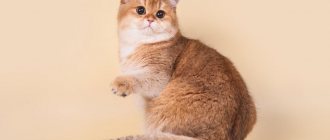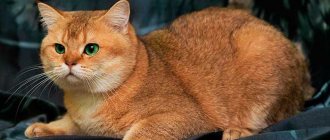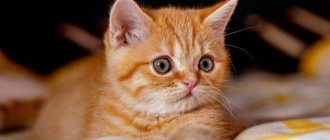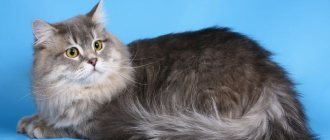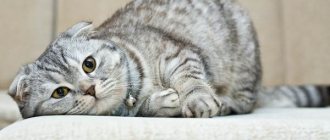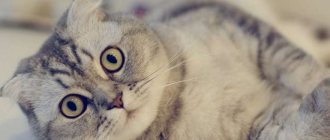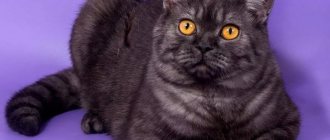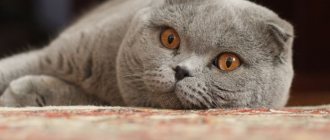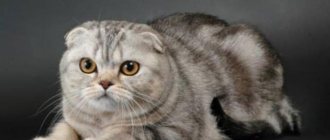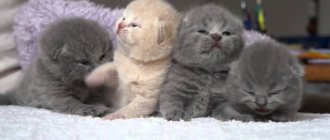Who would have thought that a simple defect would become the basis for the emergence of an incredibly cute breed? Yes, these bent ears used to be considered a cat's fault, and only in 1974 did the whole world recognize fold-eared cats as a test breed. And already in 1978 they won the hearts of every judge and spectator at exhibitions. What can we say if photographs of these cats even now receive thousands of likes on the Internet.
Kinds
Interestingly, kittens are born with straight ears, and up to 3 months they can droop on their heads. Depending on whether the ears are flattened or not, Scottish Folds are divided into 4 types:
- Scottish Straight - short hair and straight ears;
- Scottish Fold - short coat and drooping ears;
- Highland Straight - long hair and straight ears;
- Highland Fold - long coat and drooping ears;
Hereditary diseases of Scottish Straights
With proper feeding, Scottish Straight cats do not suffer from problems with the musculoskeletal system. They are deprived of the “loop ear gene,” which deforms not only the auricle, but also the rest of the cartilage in the body. But besides osteochondrodysplasia, there are a number of genetic diseases to which Scottish cats are susceptible.
Hypertrophic cardiomyopathy
A hereditary disease that affects Scottish, British cats, Maine Coons and other breeds. In sick animals, the walls of the heart gradually thicken, and its cavities become smaller. The blood pumping gets worse and worse, and eventually the young animal dies. Pulmonary edema can be triggered by anesthesia (for example, during castration surgery), stress, and physical activity.
All Scottish Straights are recommended to have a cardiac ECHO before general anesthesia or as planned upon reaching 1 year of age.
Young Scottish Straight
Polycystic kidney disease
The Scots were “rewarded” with this disease by the Persians, who were actively used in breeding the breed. Polycystic kidney disease is insidious in that it can be hidden for a long time. An animal with excellent appearance may win shows and produce several litters before succumbing to progressive kidney failure.
There are genetic tests that can reliably determine whether a cat is a carrier of polycystic disease. But no one can oblige breeders to do research before breeding. If the parents of your Scottish kitten have not passed such a test, you can examine the kitten you like at your own expense before purchasing.
Highland Straight Blue
If the Scottish Straight is free from hypertrophic cardiomyopathy and polycystic kidney disease from birth, then with good care it will live a long life.
Description
Everyone has at least once seen a blue Scottish Fold cat on the Internet, their photos are incredibly popular there, so this description will be familiar to you.
The main difference from other breeds is, of course, drooping ears; this feature became the breed-forming feature. Cats of this breed are similar to plush toys in both their appearance and character, but more on that later.
The weight of Scots varies greatly depending on the sex of the animal: females weigh 4-5 kg, and males reach the level of 10 kg. They have a short and strong neck, on which there is a spherical head with flattened ears and a humped nose.
The paws are massive, but not very long, but this does not in the least interfere with the animal’s mobility. The fur is short and dense, which is why these cats are often compared to plush toys. The tail is wide, but short, while tapering towards the end.
Look - Snowshu: description and characteristics of the cat, care and maintenance
Note!
- Snowshu: description and characteristics of the cat, care and maintenance
- Munchkin: description and characteristics, care and maintenance of a short-legged cat
Thai cat: description and characteristics, care and maintenance, choosing a kitten
Scottish Folds come in a variety of colors, from solid to striped, so you can find almost any coat pattern.
Appearance of Scottish Straights and coat types
Scottish cats seem to many to be the ideal of feline beauty. These noble animals are harmoniously built - without extreme features of appearance. The sizes are average: cats weigh 3-3.5 kg, males 3.5-5 kg.
Scottish Straight silver tabby color
You can recognize a Scottish Straight by its round head with round eyes. Wide nose, lush mustache pads, strong chin. The silhouette of the body is rectangular, all lines of the body are softly rounded. The paws end in round pads.
A curious Scottish Straight cat lay down in the kitchen
Scottish Straights can be any color. Thanks to the presence of Persian cats in their ancestors, the Scots received a huge number of coat color variations:
- Solid color (blue, white, black, chocolate, cream);
- Two-tone color (white combined with colored spots);
- Tabby (marbled, striped, spotted);
- Chinchilla (silver or gold);
- Tortoiseshell;
- Color point (“Siamese color”).
The bicolor color option is black and white. Scottish Straight girl
Scottish cat, chocolate tabby color
Character
The character of the Scottish Fold will appeal to many. These animals are kind, smart, moderately playful and calm. They love to play with various toys, and their favorite activity is where their owners are. It is difficult to describe how much these cats love their owners; they are ready to follow them to the ends of the earth.
These animals love attention and if your cat lacks it, he will definitely find you. Therefore, it is not advisable to get a Scottish Fold if you rarely appear at home. But in any case, don’t worry, he will wait for you and play even if he hasn’t seen you for a long time.
If you are a happy parent, then Fold will become your child’s best friend. This breed is very peaceful and does not like to scratch unnecessarily; it is not for nothing that they are often compared to soft toys because of their character and appearance.
Even in childhood, cats of this breed do not often play dirty tricks. The most they can do is hide your glasses or pen under the sofa.
Note!
- Bengal cat: description, characteristics and maintenance of an exotic breed
Norwegian Forest Cat - description of the breed, character, habits and maintenance of the Norwegian (110 photos and videos)
- Cat litter - detailed review, prices, how to choose, where to buy
Don't be alarmed if you've never heard any noise from your pet, they don't like to meow. It's funny that their voice is the opposite of their appearance, the meow of this breed is very squeaky and you will only be glad of the pet's silence.
Tartan standards
global $ads_google;
//data-ad-slot=”2475549904″ $ads_google = empty($ads_google) ? false : true; ?> if ($ads_google == false) {?> $ads_google = true; ?> } ?> The Scottish breed today is divided into two genetic lines due to breeding work. One line is associated with the British, Persians and even exotics, the other with American Shorthair cats.
The standards of each subspecies will be discussed below, but all Scottish cats have common appearance features that indicate their belonging to the breed.
The head must be round in shape with large round eyes. The breed is characterized by a “childish” expression on its face. The fold-eared varieties are similar in ear shape, and the short-haired subspecies have a very thick undercoat, and resemble teddy bears.
Other breeds may simply be envious of the richness of the colors of the tartans. As a rule, the eye color corresponds to the standard coat color.
Scottish Fold breed
The Scottish Fold breed does not exceed average size. The body looks rounded, massive and muscular. The back is straight, the shoulders are strong, the chest is well developed.
The characteristic ball-shaped head has a smooth transition to the neck and a strong, well-defined chin. A short nose seems wide. The small ears, which are slightly set forward and downwards, look interesting. The tips of the ears are rounded.
The Scottish Fold looks at the world with wide, large eyes, reminiscent of an owl, and the color of the eyes will be determined by the color of the coat.
Slender round paws of medium length.
Short fur seems plush due to its density and softness. The pile does not adhere to the body.
A cat's tail can be medium or long, but always tapers to a rounded tip.
Straight-eared Scottish breed
The Scottish Straight is a beautiful cat that is small in size and has a sloping body shape. The pussy even seems miniature and compact.
Although the animal is small, its muscles are well developed, including the massive pelvic and shoulder parts. The graceful, rounded paws look strong and feel plush to the touch. The limbs of the subspecies are of medium length.
The head, like that of other Scottish cats, is located on a short but very strong neck. Scottish Straight males have distinct cheeks and whisker pads.
Representatives of this subspecies have a very neat, wide and short nose. The base of the nose and its oval shape are noteworthy.
Smooth, straight ears with soft and elastic cartilage stand out on the rounded skull.
Scottish Straights are similar in eye shape and look to an owl: they have the same large round eyes. Eye color also depends on coat color.
The soft fur coat without thick undercoat resembles plush. Wool is very dependent on the quality of nutrition and climate.
The length of the tail depends directly on the body parameters of the animal, but has a characteristic narrowing towards a rounded tip.
Scottish Fold longhaired breed
As already mentioned, the Highland Fold is a Scots cat with long hair.
Her head is perfectly round, she has a strongly pronounced chin, a strong strong neck, a medium body and short limbs with sloping paws. Round eyes set wide apart.
Males have noticeable cheeks and a short and wide nose. Cats' ears seem to be folded down and forward, and seem to be buried in long hair.
The tail of cats is medium and tapering to the tip.
The wool is light, soft and silky.
What is the difference between the British cat breed and the Scottish cat breed?
global $ads_google;
//data-ad-slot=”2475549904″ $ads_google = empty($ads_google) ? false : true; ?> if ($ads_google == false) {?> $ads_google = true; ?> } ?> There was a whole unpleasant story with Scottish Folds in 1971, associated with the reluctance of the largest felinological organization in Great Britain to include the breed in the official lists. Thanks to the geneticist R. Peltz, the problem was solved. Europe received Scottish Folds from British cats, America - from American Shorthairs. However, in 1976, the CFA finally settled the disputes.
Not everything was smooth with the straight cats either: the cats are very similar in appearance to the British, to whose genes they owe their origin. In 2004, it turned out that the pussies of Scotland differ in character, skeletal mass and skull structure. But today it is prohibited to cross British and Scottish cats.
Scottish cat colors
Scottish cats have a wide choice of colors.
Beautiful colors of chocolate tones:
- plain;
- tortoiseshell;
- tabby;
- smoky;
- bicolor;
- van;
- shaded;
- chinchilla;
- ticked;
- point
The breed is characterized by tipping - the pigment is not distributed evenly along the length of the hair, but only colors the tip of the hair, leaving the rest white. Tipping is found in chinchilla colors, shaded and patterned.
Bicolor colors are popular, consisting of two tones: half white, half blue, cream, red and tabby.
Point colors are popular: the body is light in color, and the muzzle and all protruding parts of the body will be darker. For Scottish cats this is:
- seal point;
- lilac point ;
- blue point;
- chokelit point;
- cream point;
- cake point.
No less beautiful are smoky cats with a uniform coat tone and a white-silver base of the pile.
Solid color Scottish cat:
- blue;
- ebony;
- white;
- lilac;
- faun;
- cream;
- cinnamon.
The rarest colors of tartans today are black, white, chocolate and red.
Care
Scottish Folds are very easy to care for. Once a week, inspect your ears and clean them with a cotton pad soaked in hydrogen peroxide. Due to the nature of the breed, the ears often get dirty, and they must be cleaned to avoid diseases.
Cats also often develop plaque on their eyes, which should be cleaned to prevent disease. You can do this with a cloth, just wet it with warm water and you’re good to go.
If you decide to cut your pet’s nails yourself, then do it carefully; you need to cut at a short distance from the blood vessels (a little further than the red part of the nail).
To protect the furniture, train your Fold to use a nail polish, but know that this will not be easy, because cats of this breed are very stubborn.
Note!
- Ragdoll - 110 photos, breed description, price, character and owner reviews
- British shorthair cat - description of the contents, selection of food, personality traits and breed (105 photos)
Maine Coon: description of the breed, character, size, price and features of keeping a cat (110 photos + video)
Advice for those who have not yet decided
If you are still wondering whether to get a kitten and which breed is suitable, then the advice is this: you need a little Scotsman!
If you have a child, then a red fold-eared kitten will be suitable, as it will be especially friendly and attached to children and other animals. It is best for the cat to be raised with children, then their bond will be stronger, and the child will gain the necessary experience of caring for a living creature. Remember that a ginger cat brings good luck.
However, before getting a pet, think about whether you have the strength and time to take care of it, since any animal requires a lot of dedication.
Nutrition
When choosing food, do not skimp and choose products of at least super-premium class, this way you will protect your pet from stomach diseases.
If you feed your cat natural products, you will have to fork out for fish, lean meat, cheese and various dairy products. It will only be whites.
The animal can get carbohydrates from bread, various cereals and potatoes, and fats from egg yolks and vegetable oil. With such feeding, it is necessary to add vitamin-mineral complexes to the food.
Features of cat breeds with long ears
If we compare cats with humans, we can say that all mustachioed pets have disproportionately large ears. The hearing organs consist of 3 parts:
- external, responsible for collecting sound;
- the middle one, transmitting the sound signal to the next section;
- internal, converting sound vibrations into nerve impulses.
In terms of hearing quality, cat breeds with large ears are in no way superior to their closest relatives. They also detect ultrasound and can clearly distinguish the voices of their owners within a range of 3 km.
Thanks to their developed muscles, cat ears have high mobility. This feature is used for nonverbal communication and for directed perception of distant signals. At the slightest noise, the furry “locators” turn towards its source and record the level of possible danger.
The main advantage of long-eared cats is more developed thermoregulation. Under the thin skin of the ear there are a large number of blood vessels.
The larger the size, the faster the blood cools. In hot weather, it actively irritates the ears, making them red and hot. Under the influence of air currents, part of the heat is transferred outward, reducing the overall body temperature.
Another feature concerns care. A large and open canvas collects a lot of dirt and dust, and also produces an increased amount of sulfur. All this attracts pathogenic microorganisms and contributes to the development of ear diseases.
For prevention, it is necessary to remove accumulated dirt every 5-7 days using special products or a cotton pad soaked in warm water or olive oil.
Health
Scottish Folds suffer from a large number of genetic diseases, which is why they often suffer from serious incurable diseases. Healthy pets are very hardy and have strong immunity.
The most eared cats
Most large-eared cats belong to the eastern oriental group or are descendants of wild cats from warm countries. Both of them are endowed with a very specific character, so before purchasing an unusual pet, it is recommended to carefully study its advantages and disadvantages.
Siamese
Slender Siamese have elongated body lines, expressive bright blue eyes and huge ears that widen at the base. The shape of the “locators”, like the heads, is strictly triangular.
"Siamese" are often called touchy and vindictive, but their owners assure that these accusations do not correspond to reality. In fact, mustachioed pets are simply more demanding and capricious. Inappropriate behavior on their part is the result of a lack of communication with a person and constant groundless punishments.
IMPORTANT!
Siamese cats are often confused with Thai cats. The latter have a less graceful physique and more rounded shapes.
Oriental
The ears of these graceful and lean pets resemble giant fans. They look funniest on kittens. Due to intensive growth in the first months of life, oriental babies differ from Yoda from Star Wars only in a more natural color.
Oriental cats are completely devoid of oriental arrogance and arrogance. Their favorite place is next to their owner, so the latter has to put up with constant surveillance in the bath and toilet.
“Orientals” are not without curiosity. Left alone, they will definitely explore every corner of the house. They inspect closed rooms with particular zeal.
Rex
This group includes the curly-haired Devon and Cornish rex. Their difference from each other is as follows:
- Head. Cornish cats are often called eggheads, while Devons have a beautiful heart-shaped head.
- Ears. Cornish ears are slightly smaller and narrower at the base.
- Body proportions. Devons have a classic compact build, while Cornishes have an elongated oriental build.
- Wool. Cornish curls look more well-groomed and orderly, while Devon curls are always tousled.
Despite the external differences, the character of the rex is almost identical. They become strongly attached to their owner, have high intelligence and remain playful for a long time.
Sphinxes
“Eared cats” include not only fluffy cats, but also hairless cats. This group includes 3 types of sphinxes:
- Canadian. Strong and muscular animals with a wide head and large lemon-shaped eyes.
- Donskoy. Massive cats with a noticeable belly, but clearly defined cheekbones and eyebrows.
- Peterbald. Light and elegant owners of a wedge-shaped head, slanting almond-shaped eyes and the largest “locators”.
Due to the lack of fur, all these pets are vulnerable to low and high temperatures. In frosty weather, they must be dressed in warm clothes, and in the summer, outside, they must be smeared with protective cream.
Elf
Elves were created by crossing the Canadian Sphynx and the American Curl. From the first parent they inherited the impressive size of the ears, and from the second - the characteristic curl of both cartilages.
Funny mustachioed pets are famous for their canine devotion and boundless love for children. They can even be left with babies, as elves will never harm their owner. They cannot stand loneliness and constantly try to be close to people, so it is better for busy people to choose more independent animals.
Savannah
According to the standard, savannahs have large rounded ears and a wedge-shaped head. The price of kittens is determined by the degree of relationship with the serval. The babies from the F1 generation are endowed with the maximum similarity to the wild ancestor, but due to their wild nature they are used only for breeding purposes.
IMPORTANT!
The sounds made by the F1 generation can be quite frightening. These cats not only meow, but also hiss like a snake, and also chirp like a serval.
For a family with children, it is better to take kittens from the F3 or F4 generation. Their blood contains only 25 or 12.5% Serval DNA.
Caraquet
The caracat is a miniature version of the lynx. From their wild ancestor, these pets inherited an exotic color, large ears with tassels and huge expressive eyes. The caraquet got its character from a domestic cat.
Graceful pets are friendly and curious. They are not prone to damaging furniture and do not require keeping in an enclosure. Caraquet's favorite game is fetching the ball. He can also be trained to wear slippers.
Havana brown
Havana Browns were created by crossing a Siamese and a black domestic cat. As a result of the experiment, they acquired a chocolate coat and a classic Siamese appearance.
These “mustaches” are not only not afraid of strangers, but truly love them because of their innate curiosity. When the doorbell rings, they are the first on the threshold, trying to get as much attention as possible from the guests. Due to their craving for society, Havanese always try to be in the center of events and suffer greatly if they are left alone for a long time.
Maine Coon
Maine Coons are heavyweight cats bred in the American state of Maine. Due to the need to live in harsh weather conditions, these animals have acquired a thick and warm undercoat, and additional tufts of hair have appeared on their paws. With the help of the latter, Maine Coons do not fall under the snow, but glide freely along its surface.
Fluffy dogs are famous for their friendliness and calm nature. Pranks on their part are very rare.
Despite their love for tactile contact, Maine Coons do not accept familiarity and open violation of personal space. To avoid conflict, pick them up only after receiving the appropriate permission.
Javanese
Long-haired Javanese are close relatives of Orientals, so their appearance is largely identical. The name of this breed comes from the Indonesian island of Java, where the most famous tea plantations are located.
Javanese prefer an active lifestyle, so if possible they should be kept in spacious private homes. Thanks to their well-developed fingers, they can easily open doors and even manage to catch objects.
Bambino
Bambino is the result of a marriage between a baby munchkin and a Canadian Sphynx. From his bald parent, the cat inherited large ears, which look very comical against the background of his miniature body with short legs.
Bambinos retain their childlike playfulness until old age, so they are recommended for children who are ready to entertain their pets all day long.
The only nuance of this breed is fragility. When playing together, children should be aware of the boundaries of what is permitted, so as not to inadvertently injure the animal.
Turkish Angora
The presence of large ears with a wide base is also fixed in the standard of the snow-white Turkish Angora. There are always small tassels at their tips, and thick fur tufts inside.
Turkish Angoras are playful, but extremely independent and willful. They calmly endure loneliness and find entertainment without any problems. They have a special love for hunting and fishing. If you live in an apartment, be sure to buy a collection of mice for your pet or fill her with a basin of water.
Chausie
The wild appearance of the Chausie is explained by its relationship with the jungle cat. According to the standard, representatives of this breed must have large triangular ears located directly on the top of the head. On the reverse side they are decorated with dark spots resembling eyes.
Interesting!
Chausies love to swim and quickly learn to be on a leash, just like dogs.
Chausies are cheerful and sociable pets who love to cuddle on their owner’s lap. Their penchant for independence manifests itself in the periodic “burial” of hair ties and other simple artifacts.
Serengeti
To develop the breed, breeders used Maine Coons, Orientals, Abyssinians, European Shorthairs and Bengals. The latter gave the cats a wild color, and the first two gave them long and impressive “locators”.
The Serengeti is endowed with a developed territorial instinct and a tendency to dominate. Because of these characteristics, they often conflict with other pets for the title of leader.
Balinese
Another close relative of the Siamese is the Balinese. The standards of these cats are almost identical. The only difference is the presence of semi-long wool in the “Balinese”.
Representatives of this breed are ultra-communicative and playful. If excessive intrusiveness and periodic destruction of the apartment are unacceptable for you, then instead of the “Balinese”, take a closer look at the calmer and more self-sufficient Maine Coon.
Do you like the article? 0
